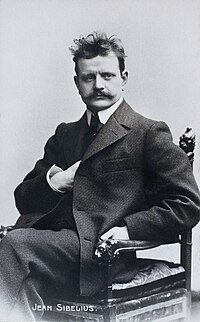Loading AI tools
Symphony in four movements by Jean Sibelius From Wikipedia, the free encyclopedia
The Symphony No. 1 in E minor, Op. 39, is a four-movement work for orchestra written from 1898 to 1899 by the Finnish composer Jean Sibelius.
| Symphony No. 1 | |
|---|---|
| by Jean Sibelius | |
 The composer (c. 1900) | |
| Key | E minor |
| Opus | 39 |
| Composed | 1898–1899, rev. 1900 |
| Publisher | Fazer & Westerlund (1902)[1][lower-alpha 1] |
| Duration | 38 mins.[3] |
| Movements | 4 |
| Premiere | |
| Date | 26 April 1899[4] |
| Location | Helsinki, Grand Duchy of Finland |
| Conductor | Jean Sibelius |
| Performers | Helsinki Philharmonic Society |
The work was first performed on 26 April 1899 by the Helsinki Orchestral Society, conducted by the composer, in an original version which has not survived. After the premiere, Sibelius made some revisions, resulting in the version performed today. The revised version was completed in the spring and summer of 1900, and was first performed in Berlin by the Helsinki Philharmonic, conducted by Robert Kajanus on 1 July 1900.
The symphony is characterized by its use of string and woodwind solos; the first movement opens with a long and discursive clarinet solo over a timpani roll; (this idea returns at the start of the fourth movement, fortissimo in the strings, with wind and brass chordal accompaniment), and subsequent movements include violin, viola, and cello solos.
Most performances of the work last between 35 and 40 minutes. Many conductors choose to slacken the speeds suggested by Sibelius's metronome markings, particularly in the fast part (allegro energico) of the first movement. Because of this, many versions of the symphony are about 38–40 minutes long (the publishers suggest the duration is 40 minutes[5]). In Osmo Vänskä's recording of the work, released in 1997, the first movement is played at the metronome mark suggested by Sibelius and takes 9:42 (compared with the 10+1⁄2–11+1⁄2 minute duration of most other recordings).
2 flutes (both doubling on piccolo), 2 oboes, 2 clarinets (1st and 4th movements in A, 2nd and 3rd in B♭), 2 bassoons, 4 horns, 3 trumpets, 3 trombones, tuba, timpani, triangle, bass drum, cymbals, harp, and strings
Like most symphonies, it is in four movements:



The first recording was made by Robert Kajanus with the London Symphony Orchestra for the HMV label in May 1930.
Seamless Wikipedia browsing. On steroids.
Every time you click a link to Wikipedia, Wiktionary or Wikiquote in your browser's search results, it will show the modern Wikiwand interface.
Wikiwand extension is a five stars, simple, with minimum permission required to keep your browsing private, safe and transparent.